|
Clyno Cars
In its heyday Clyno was the third largest car
manufacturer in the UK after Austin and Morris. It proudly boasted that
it offered a price level as low as any car of like rating in the world,
and a value vastly higher.
It all began when cousins Frank and Ailwyn Smith of
Thrapston, Northamptonshire designed and manufactured a pulley with a
variable drive ratio, for belt-driven machines. They called it the
"inclined pulley", which soon became abbreviated to the "clined" and
finally Clyno.
In 1909 they began to manufacture motorcycles, and in
1910 the company moved into a factory at Pelham Street, Wolverhampton,
on the site of Fort Works. The factory had previously been
used by the Stevens Brothers for the manufacture of petrol engines. |
| The Stevens Motor Manufacturing
Company's factory, as it was in about 1907.
The buildings were occupied by Clyno
in 1910.
A little while later Clyno also acquired Ashes works across the road. |
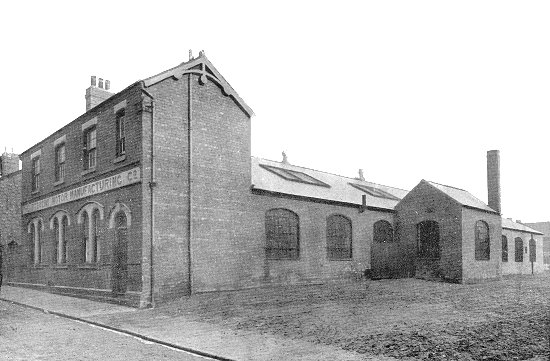 |
|
 |
How the factory looked in
2012. It has been greatly extended.
|
| |
|
| Read about Clyno's
early years. |
 |
| |
|
| Sales were good and the company prospered. During
the First World War, Clyno signed an agreement with the Russian War
Commission at the Savoy Hotel in London for the supply of solo and
combination machines for the Imperial Russian Army. During the war large
numbers of heavy motorcycle combinations were produced for both the
British and Russian armies. They consisted of mobile machine gun units,
ammunition carriers and solo machines. During 1918 and 1919 Clyno also
built a number of ABC Dragonfly aero engines. In 1916 Ailwyn left the
company after a disagreement with Frank. He went on to pursue a highly
successful career with Samuel Taylor & Sons of Brierley Hill where
he designed staircases for the side of ships, chains and
anchors etc. |
| After the war it seemed that the Clyno Engineering
Company would have a bright future.
A new motorcycle, the highly
acclaimed 'Spring 8' with a top speed of 50m.p.h. was launched in 1919
at the Olympia show.
Unfortunately it would be two years before the
machine went into production. |
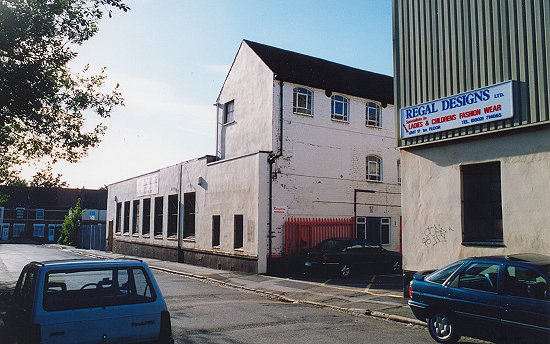
Ashes Works, Clyno's second factory in
Pelham Street, now demolished. |
|
In 1920 the post-war motorcycle market collapsed,
and the original works manager Henry Meadows, left to form the well
known engine manufacturing company, Henry Meadows Limited at Fallings
Park.
At the time, large numbers of cheap ex-WD machines
were available. To compound the problem, there were also shortages of
materials, which didn’t help production, and last but not least, the
Russians failed to pay for the military motorcycles they had received
during the war. As a result the company's financial backers withdrew,
and the Clyno Engineering Company went into liquidation.
Rebirth
Frank Smith very much wanted to produce cars, and
with this in mind he formed the Clyno Engineering Company (1922) Limited
with a capital of £100,000. Frank’s father William Smith was chairman
and Frank became managing director.
Initially both cars and motorcycles were produced,
but by the autumn of 1923 motorcycle production had ended. The new
company stated that no Clyno machines would be displayed at the 1923
Motor Cycle Show. |
|
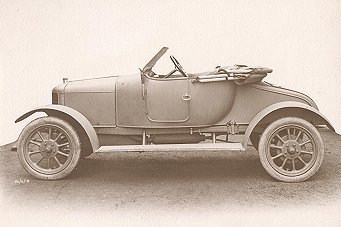
Clyno's prototype car. |
The new works manager was Leslie Munn. The new
sales manager, James Cocker had previously made a name for himself in
motorcycle racing.
A prototype 2 seater car had been built before the
end of the war, but it was abandoned, possibly due to lack of finance.
The car had been designed by Charles M. Van Eugen who had recently
joined the company. |
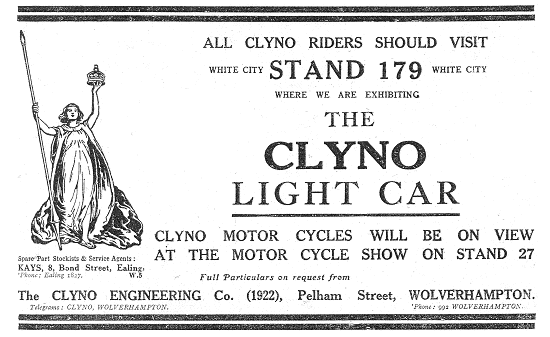
An advert from 1922.
| The first production car made its debut at the 1922
Motor Show. It was designed by George Stanley who came from Triumph, and
A. G. Booth who did the detail design.
The car had a 10.8hp. 1,368c.c.
four cylinder Coventry Climax engine, a Clyno 3 speed gearbox, electric
lighting, and initially sold for £250.
Most of the parts were made in-house
including the steering, brakes, and gearbox. |
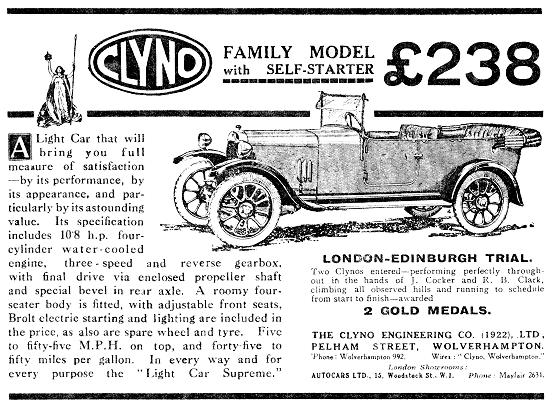
A Clyno advert from 1923 showing their
first production car. |
|
Clyno prices were always kept low to undercut the
competition, in this case Morris. In the following year the selling
price fell to £238, complete with an electric starter. A 2 seater
version was introduced, and around 522 cars were built that year, and
distributed by Rootes. The agent in Wolverhampton was Cyril Williams.
The car had some success in reliability trials,
winning 2 gold medals in the 1923 London to Edinburgh Trial, and a
silver medal in the Scottish Six Day Trial.
In April 1924 the product range increased with the
introduction of the 11.9hp., known as the Clyno 13hp. and a 10.8hp.
saloon. Prices ranged from £275 to £350. In July the cars had some
success at Brooklands when racing motorcyclist Ray Abbott won a race,
organised by the Essex Motor Club, at 70.74m.p.h. driving his specially
tuned Clyno car.
In June a new 'Sports Clyno' appeared, with Swallow
bodywork. It was a door-less two seater with a slimline body, and sold
for only £250. At such an attractive price, sales could have been high,
but only 25 were built because of the difficulty in keeping up with the
large demand for the other models.
|
|

Roy Surman's Clyno Tourer from 1924. |
1924 also saw the introduction of the 'Weymann'
saloon and the 'Royal' 2 and 4 seater tourer. They featured four wheel
brakes and balloon tyres. Prices were again reduced and sales soared,
around 3,000 were built in the first 6 months alone.
Frank Smith and the other directors had an
obsession to beat the Morris Motor Company at their own game, by a
sustained price-war.
At this time Clyno had become a serious competitor,
but was always under-capitalised. It has been said that the company was
floated on a bank overdraft. |
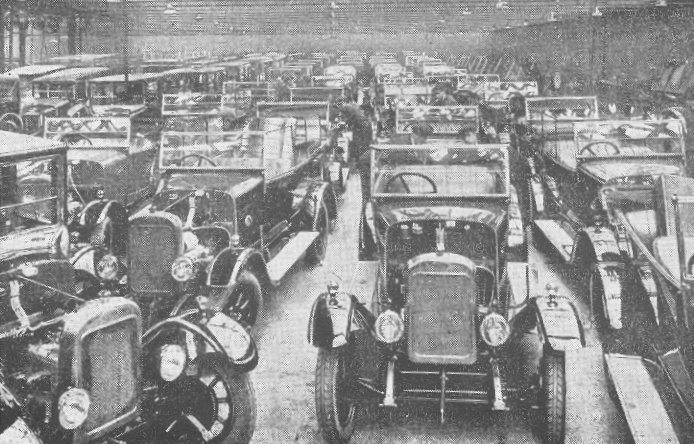 The Finishing Shop.
The Finishing Shop.
| By April 1924, an export model had been developed.
It had a higher ground clearance, slightly larger
wheels, and was exhibited at the Empire Exhibition at
Wembley. Standard models were also exported. |
| In October 1925 the company launched the Clyno
13hp. car which proved to be very popular.
The car, actually rated at
11.9h.p. in an R.A.C. test, had a 1,496c.c., side valve engine, 3 speed
gearbox and internal, fabric lined, cone clutch.
There were 2 horns, one electrically operated, and the
other bulb operated.
It had a petrol gauge and a 3 pane windscreen, with two
upper adjustable panes, and a Smith mechanical windscreen
wiper. |

Another view of Roy Surman's Clyno Tourer. |
|
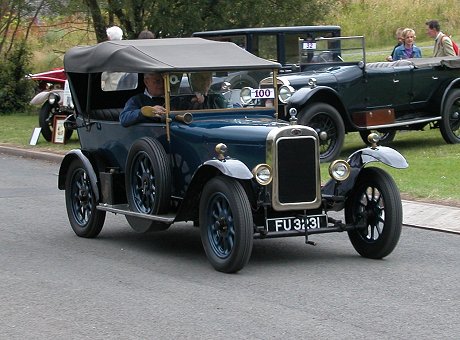
A final view of Roy Surman's Clyno Tourer. |
The 4 seater car had leather
upholstery, weighed 17cwt and sold for £260.
The 2 seater version sold
for £245, the coupé sold for £285, and the 4 door saloon sold for £298.
The chassis was also available for £172.10s.
Another new model was the
Regent 4 door saloon, rated at 11hp. with a fuel consumption of 35 to
40m.p.g., and a selling price of £275. |
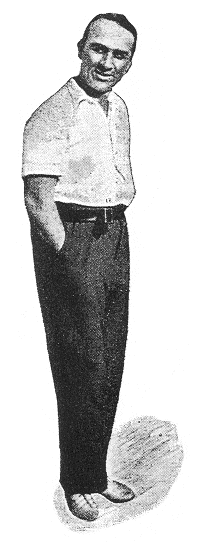
| Frank Smith. The
photograph, courtesy of Chris Smith is from the
Light Car and Sidecar magazine, 12th March 1926. |
|
1925 also saw another reduction in the price of the
10.8hp. range. The ‘Royal’ 2 seater now sold for £210, the ‘Royal’ 4
seater now sold for £215, and the 4 door saloon sold for £245.
Other
models in the range included the 2 Seater, the ‘Occasional Four’, and
the 4 Seater. At this time production had reached an average of 150 cars
a week, although many more where produced in December. It’s hard to
imagine how so many cars could have been built in the cramped conditions
at the works.
By the mid 1920s a 'flow' system of production was
in operation and the company employed around 1,000 people. The works
operated both day and night to meet the demand.
By 1926 a maximum of
three hundred and fifty cars were produced every week. A total of 13,149 Clyno cars were made in 1926. A marvellous achievement in the year of
the General Strike, which demonstrates the loyalty of the staff.
The factory at Pelham Street was enlarged, and the
'Colonial' model began to sell well all over the world. Its main markets
were in Singapore, Australia, Aden, America and Europe.
The 13hp. car was renamed the 12-28 and
produced in three forms:
The first, the 2 seater model had a dickey seat, an
all-weather hood, and sold for £215.
The second, the 4 seater model had
4 wide doors, an adjustable front seat, and sold for £220.
The third,
the saloon had a coach-built body, incorporating a sloping windscreen,
patent slam-locks, and sold for £250.
|
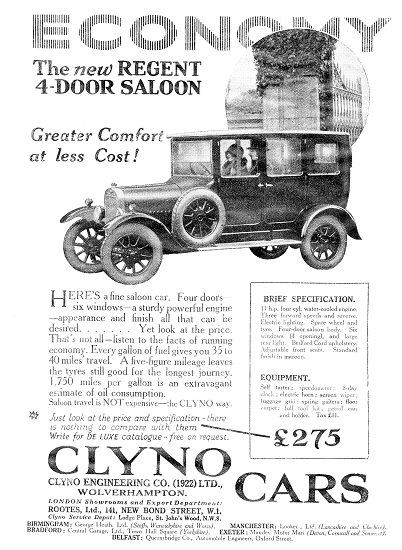
An advert from 13th February,1925.
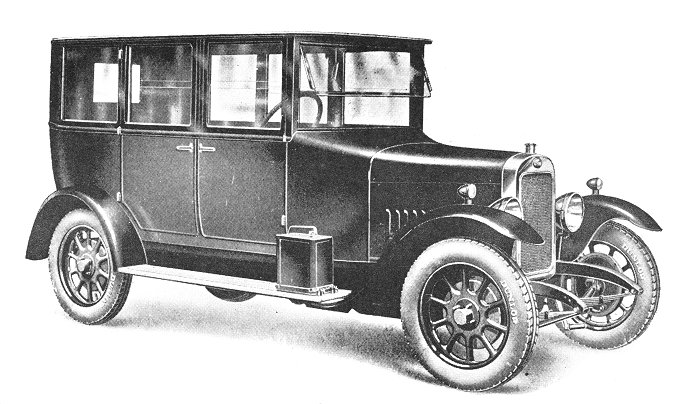
The 1925 11 hp. 4-door Saloon.
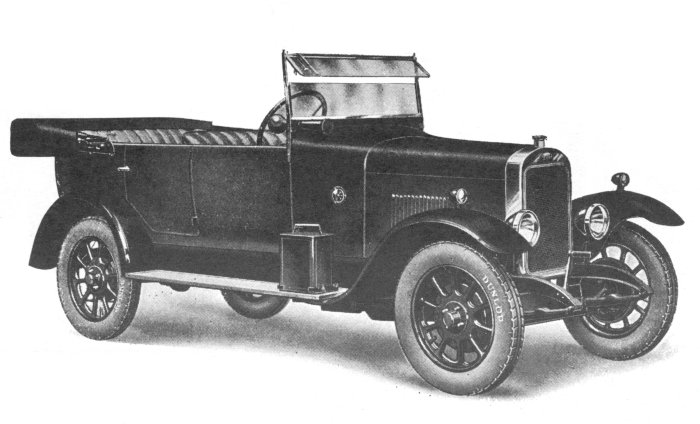
The 1925 11 hp. 'Royal' 4-seater.
|
Before the end of 1926 another new model, the
Cowley Saloon, was launched. It had two doors, four 12inch brake drums,
and sold for the incredibly low price of £199.10s.
By this time Clyno
had become the third largest car manufacturer in the country, just
behind Austin and Morris. The factory output had been greatly increasing
for several years:
In 1924 the factory output
increased by 720%.
In 1925 the factory output increased by 260%.
In 1926 the factory output increased by 210%. |
Although under-capitalised, the company had to find
alternative premises to increase production, in order to keep up with
demand.
All the available space had been used at Pelham Street.
|
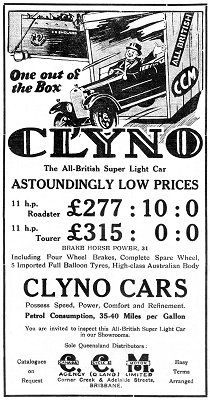
Advert supplied by Michael Pick. |
|

An advert from 26th June, 1925.
|
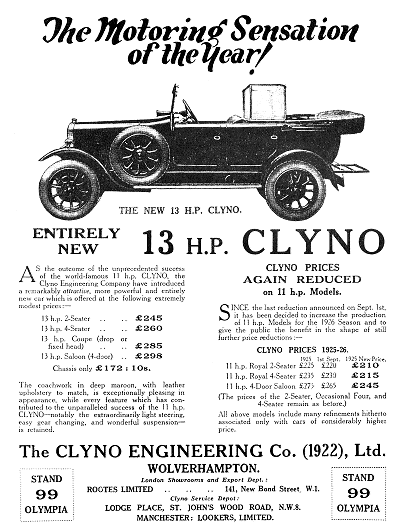
An advert from the Light Car and
Cyclecar magazine, October 2nd 1925. |
|
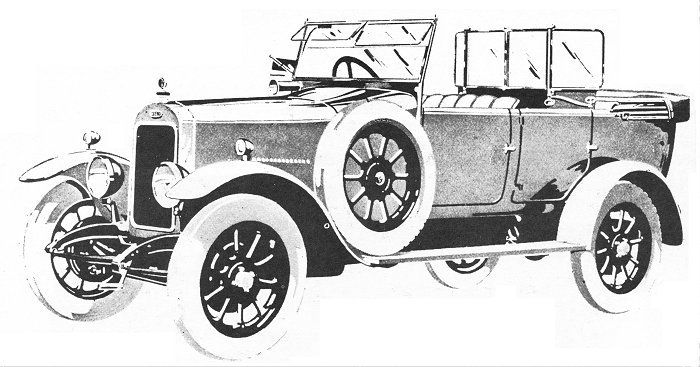
The 1926 13 hp. 4-seater.
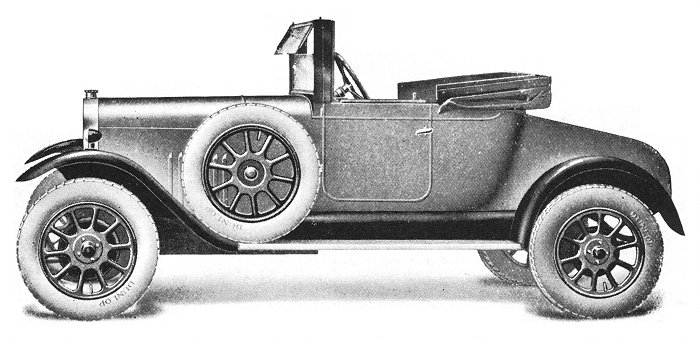
The 1925 13 hp. Coupé.
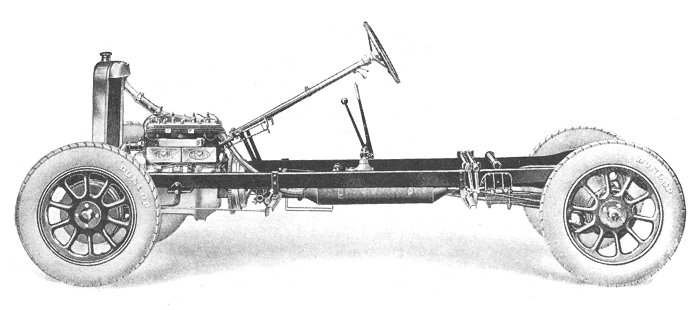
The 1925 13 hp. chassis.
| |
|
| Read an article from 1926 about the Pelham Street
works |
 |
| |
|
| 10.8hp. Clynos entering Pelham
Street from the works in 1926.
They are bound for Maude's of
Exeter,
the West Country distributor. |
 |
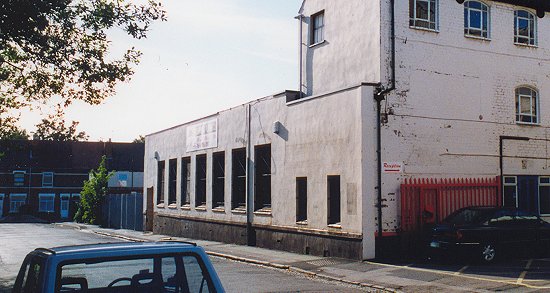 |
The same scene in 2012.
The far building has lost its upper
story, and the yard on the right has been opened-up. |

The fabric bodied Clyno 'Royal' Tourer
that is on display at the Atwell-Wilson Motor Museum, Calne,
Wiltshire. Courtesy of Brian Shaw. |
|
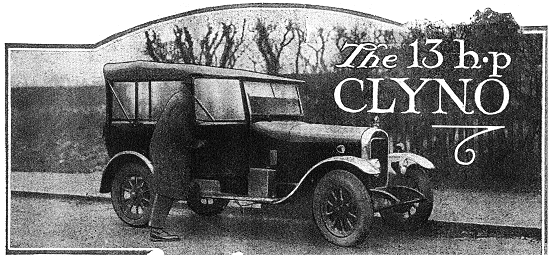
The photograph, courtesy of Chris Smith is from
the Light Car and Sidecar magazine, 12th March 1926. |
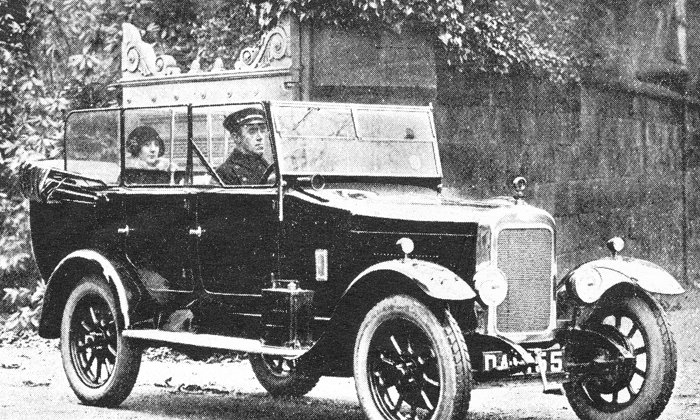
A 1926 13 hp. car.
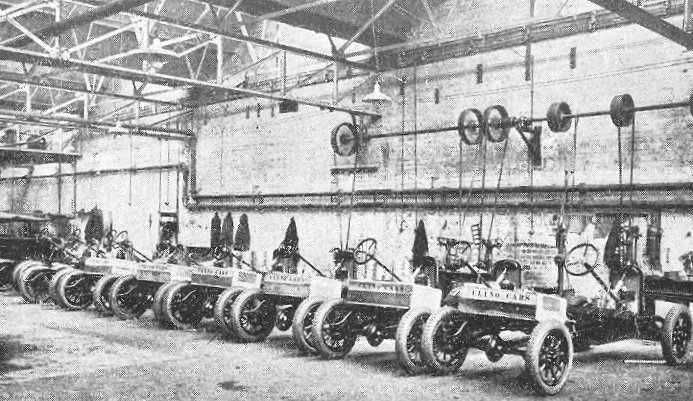
Part of a consignment of 47 chassis for
Australia.
The Bushbury Works
|
In January, 1927 the company announced a new
factory, covering 4 acres at Bushbury, financed by another bank loan.
The new factory contained some of the latest machinery, but although
production began during the first half of the year, it took a long time
to really get going. The old factory was slowly allowed to run down, and
it took until November to reach an acceptable level of production at the
new works.
The buildings at Bushbury consisted of a two storey office
block and a range of north-lit sheds. The sheds were arranged in 17ft by
28ft bays, along with 2 large shops, for chassis and engine building.
The chassis shop was equipped with an assembly line
and a large wood working shop which used machinery driven from electric
motors and overhead line-shafting. There were also bays for car
despatch and export chassis preparation. Initially 70 saloons were built
there each week. In May the luxury 'Olympic' saloon was introduced,
which had wire wheels and sold for £295. The company's financial
situation worsened; there were loans to be paid, and the whole product
range needed updating.
|
 |
| The company entered the commercial vehicle market in
January 1927 with the introduction of an 8 cwt. 11.9 hp.
delivery van based on the wide track Colonial chassis. The
vans, which sold for £172.10s.0d. proved to be quite
popular. Some were powered by the 10.8 hp. Coventry Climax
engine. |
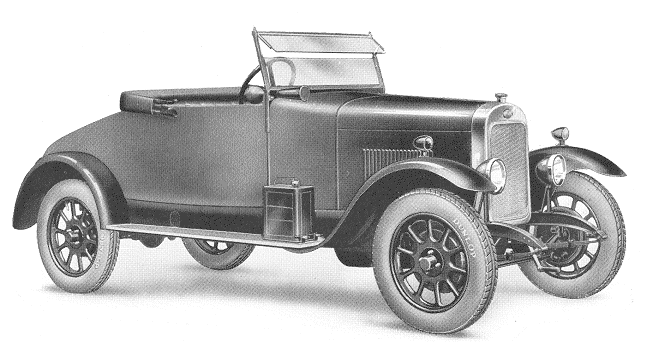
The 11hp. 2-seater from 1927.
| The interior of the 11hp.
2-seater. |
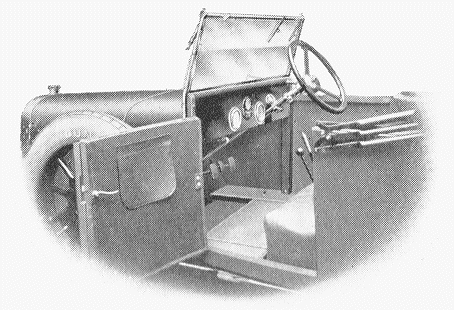 |
 |
Over the year output had fallen, mainly due to the
time lost in the change-over.
Bushbury didn’t get into full swing until
November. As a result only 7,350 of the 10.8hp. models were produced,
although 2,099 of the 12/28 models were made during the year.
Another new model, the 12-35hp. 4 door, 4 seater
tourer appeared towards the end of 1927.
Like all of the later models it
carried a new style of radiator. It sold for £220.
Other models included
a 2 seater that sold for £215 and a coach built Saloon that sold for
£250.
|
|
In the summer of 1927 Clyno developed the model
'Nine' light car.
It had a 9hp., four cylinder, side valve engine, three
speed gearbox, Cox-Atmos carburettor and a modern single plate clutch.
A.J.S. secured the contract to build the bodies at Lower Walsall Street
works.
|
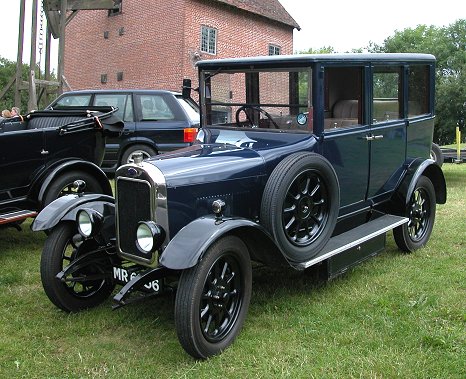
Mike Dancer's 1926 Clyno Royal at the Black Country Vehicle Rally. |
| |
|
| Read a paper that was given by
Arthur G. Booth and view some of his photographs |
 |
| |
|
| The bodies consisted of a wooden framework that
supported fabric covered panels and were built in batches of 50.
The car
was designed by Arthur G. Booth and sold for £160.
The fabric bodies
were produced as part of the effort to reduce the cost, but proved to be
unpopular.
From now on they would be fitted to most Clyno cars. The
first ‘Nine’ left Bushbury works in February 1928. |
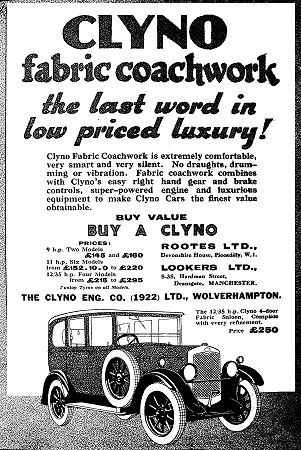
An advert for fabric bodies. |
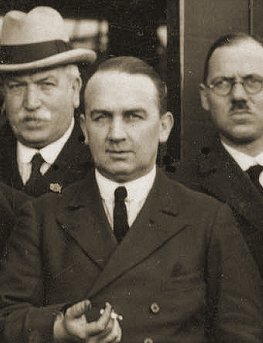
In the centre is Frank Smith.
Courtesy of John Stephens. |
At this time Clyno seemed to loose its direction. A
number of decisions were made that would soon lead to the company’s
downfall.
The first was to end the agreement with Rootes, in favour of a
network of dealers, split up into territories. This is hard to
understand because Rootes had done so much to boost the company’s sales.
Presumably the new dealer network would have accepted lower profit
margins, allowing Clyno to reduce selling prices to a minimum.
Another
bad decision, that would soon have serious repercussions, was to
discontinue the use of Coventry Climax engines, in favour of engines of Clyno’s own design, built at Bushbury works. |
| The new fabric bodied, 2 door
Clyno 'Nine' saloon leaving Bushbury Works, with some of the
Clyno staff. Third from the
right with his hand in his pocket is Arthur G. Booth
himself. Third from the left at the front (directly above
the number plate) is Frank Smith. |
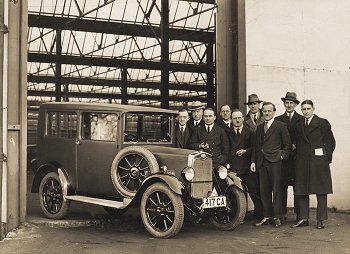 |
|

A Clyno 'Nine' tourer. |
| |
|
| View some extracts from the 1927 catalogue.
|
 |
| |
|
|
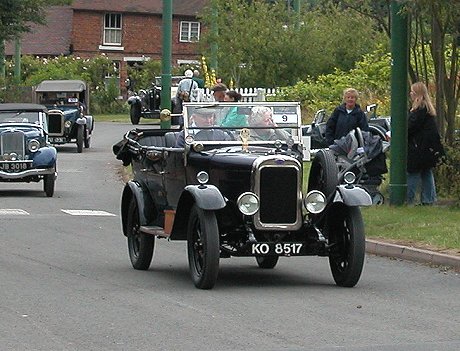
James Thomas's Clyno Royal Tourer from
1928. |
The old rivalry with William Morris continued just
as before. Less than a week after the announcement of the Morris Minor
in May 1928, Clyno announced a new version of the ‘Nine’, called the
‘Century’.
It consisted of a 'Nine' chassis covered in cheap fabric, and
sold for £112.10s. The basic 4 seater tourer had a 3 lamp lighting set,
a stove enamelled radiator shell, and a hand operated windscreen wiper,
but lacked many of the usual features that were commonplace, such as a
clock, speedometer, and dashboard lamp. The new dealers disliked the car
because their profit margins were too low. |
|
A meeting of the creditors took place in August,
after which attempts were made to increase capital investment. It took
until November to find suitable finance.
Clyno expected to build 300 ‘Century’ cars a week,
but at end only about 300 of them were produced.
The car, described as
cheap and shoddy, had been a disaster for the company, and earned the
nickname the ‘Cemetery’.
The price war with Morris had been a failure. At
the Motor Show all of Morris’s prices, except for the ‘Minor’ were lower
than Clyno’s.
Frank Smith and his co-directors had paired prices to the
minimum, they could be reduced no further.
Clyno had little room to
manoeuvre. The 10.8hp. model was discontinued, but there were hold-ups
with production because the Clyno engines were taking too long to build.
Although improvements were made to the cheap ‘Century’ body, it was too
little, too late. |
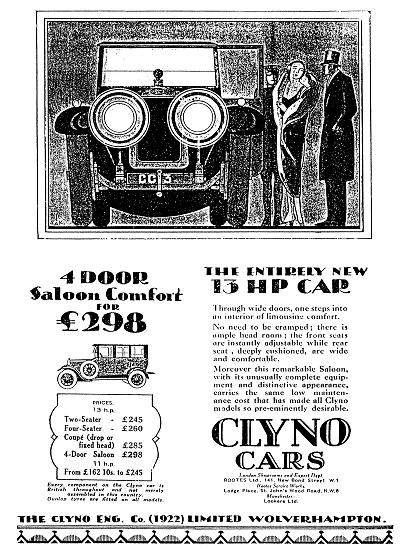
An advert from the Garage and Motor
Agent, 6th
March 1926.
Courtesy of Chris Smith. |
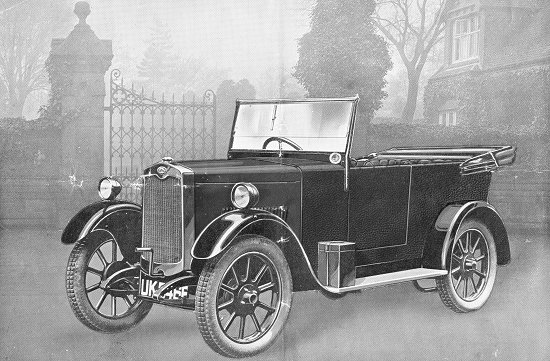
The Clyno 'Century'.
 |
Two plan views
of the Clyno 'Century'. |
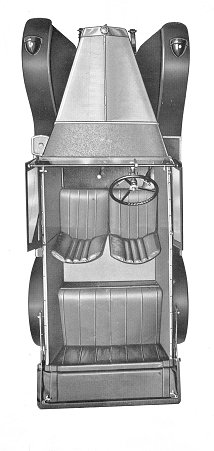 |
|
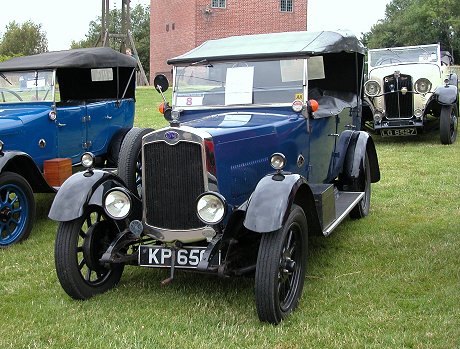
Frank Walker's Clyno Tourer from 1828. |
Even at this desperate time, Clyno set about
designing a new model, the 8 cylinder, 22hp. ‘Straight Eight’. A single
prototype was built, but that’s as far as it got.
On 11th February, 1929, E. E. Meugens,
of Bennets Hill, Birmingham was appointed as Receiver.
In September the company was wound-up at a meeting
of the creditors in Birmingham. The total debts amounted to £173,454.
|
|
F. E. Bendall of Birminghan was appointed
liquidator, and the assets were acquired by toolmaker Alfred
Herbert Limited of Coventry, who sold the jigs, drawings, and spares to
R. H. Collier & Company Limited of Birmingham. A. G. Booth, Clyno’s
designer soon moved to A.J.S. to design the A.J.S. “Nine” car.
The company had become a victim of its own success,
but had taken its cost cutting policy much too far. Clyno had invested
heavily in the new factory at Bushbury, and low sales quickly led to
cash flow problems. The company had always suffered from a shortage of
capital and had borrowed heavily to fund the new factory, and update the
machinery. The last straw, the ‘Century’ destroyed Clyno's reputation,
and led to its ultimate demise. During Clyno’s lifetime, over 15,000
motorcycles and between 36,000 to 40,000 cars had been produced.
All traces of the Bushbury factory have now
disappeared. Most of it had been destroyed by fire in the 1990s. It is
thought that only 100 or so Clyno cars survive, including the prototype
“Straight Eight”. They are a reminder of one of Wolverhampton's leading
vehicle manufacturers, and hopefully will continue to be so for many
years to come. |
|
The front of the Bushbury works, as it is was in
2000.
The site has now been redeveloped. |
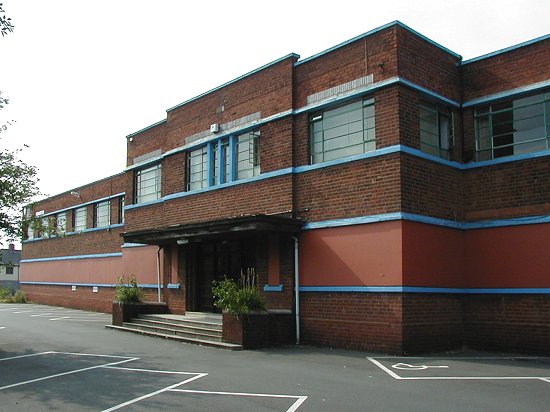 |
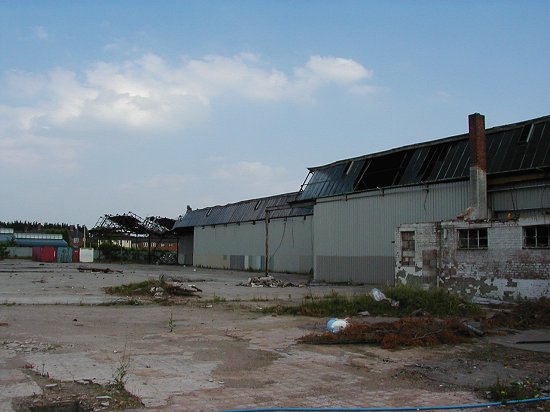 |
All of the Clyno factory at Bushbury has now
disappeared.
This view shows what was left in 2000. Most of it had been
destroyed by fire in the 1990s. |
| The western end of the factory. |
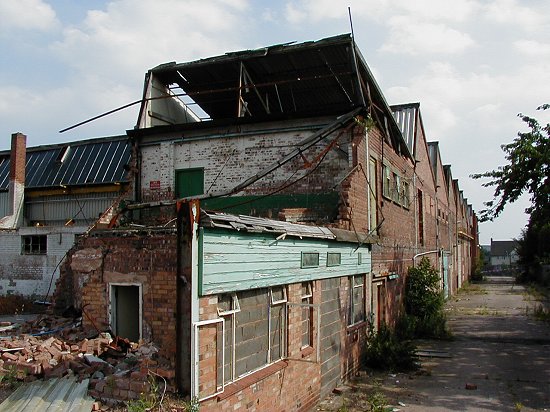 |
 |
A final view of the factory, again
looking at the western end. |
| This advert from 1937 shows just
how long it took for Alfred Herbert to sell the factory.
It was eventually purchased by Britool
Limited, who were there for many years. |
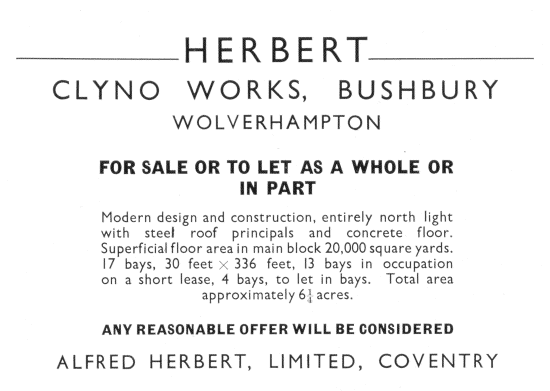 |
 |
The interior of the Bushbury
factory in the early 1930s. It is from a sales advert and
gives an impression of the size of the building. |
Clyno
products
|
Keith Ball's Clyno Royal Tourer from 1926. |
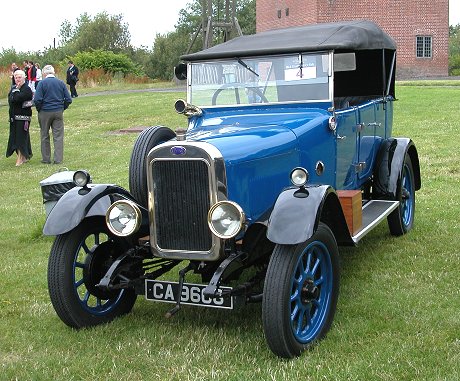 |
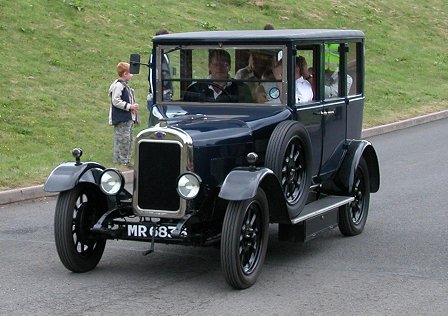 |
Mike Dancer's Clyno
Royal from 1926. |
|
Another view of Mike Dancer's Clyno Royal from
1926. |
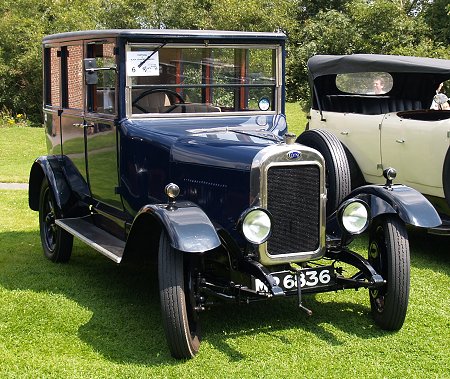 |
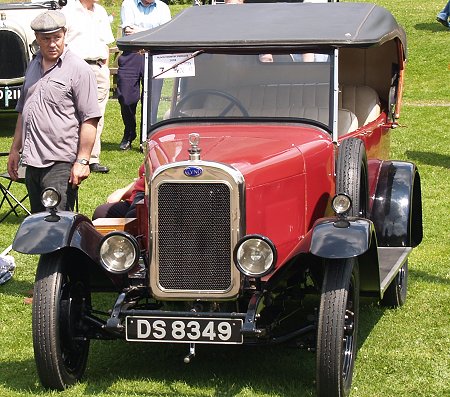 |
Suzy Flynn Owen's 10.8hp. Clyno Tourer
from 1926. |

The engine in Nick Lacy Hulbert's 10.8hp. Clyno
Tourer from 1926
| A front view of a Clyno 'Century'
showing the later style of radiator. |
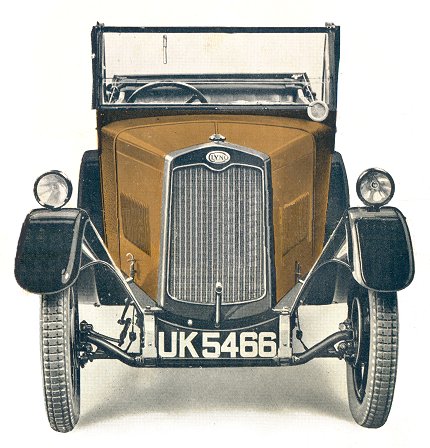 |
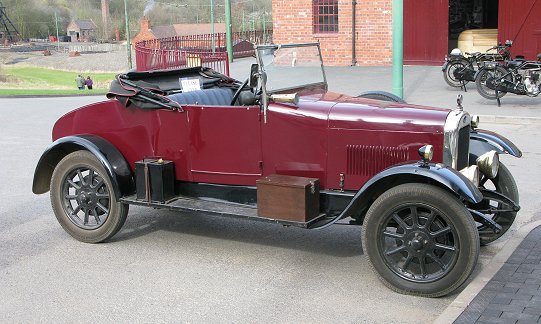 |
The 1927 Clyno Tourer that's part of
the collection at the Black Country Living Museum, Dudley.
|
|
Another view of the 1927 two seater Clyno
Tourer from the Black Country Living Museum's collection. |
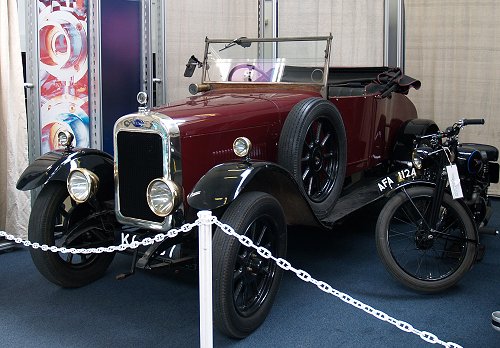 |
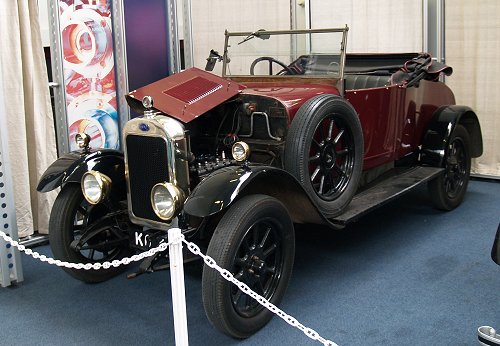 |
A final view of the 1927 two seater Clyno
Tourer from the Black Country Living Museum's collection. |
|
James Thomas's Clyno Royal Tourer from
1928. |
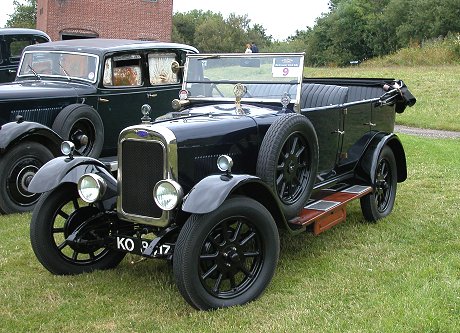 |
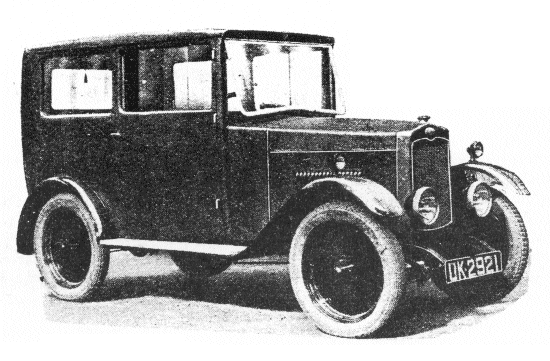 |
A 2 door fabric bodied 'Nine' saloon. |
| A version of the 11hp. chassis
that was launched in May 1927 as a dual-purpose Clyno
saloon, intended for business purposes during the week, and
a pleasure vehicle at weekends.
The rear seat could be removed and
replaced with specially made, adjustable shelves, as in the
photograph. The car sold for £210. |
 |
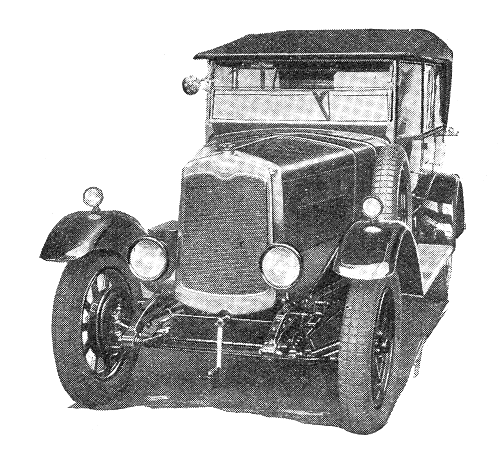
The Clyno 12-35hp. four door, four seater
Tourer launched in the autumn of 1927. Like all of the later
models it carried a new style of radiator. It sold for £220.
Other versions included a two seater that sold for £215 and a
coach built Saloon that sold for £250. |
|
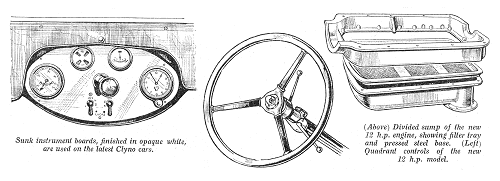
Some features of the 12hp. models. |
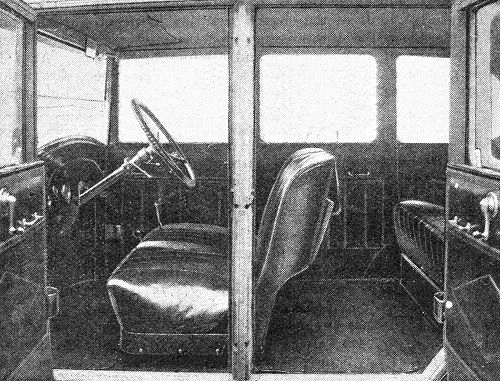
The interior of the 12hp. Saloon showing
the 6 interior lights, separate front seats, 4 winding windows
and ample leg room. |
|
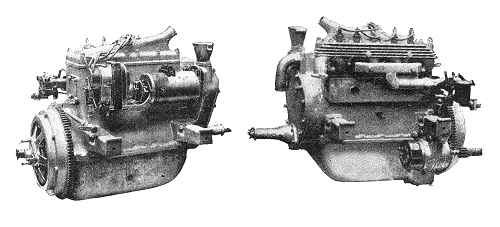
The new 12hp. engine with a two-part sump. |
|

The 2 seater 11hp. Clyno. |

The line-up of Clynos at the 2009 Festival of
Black Country Vehicles.
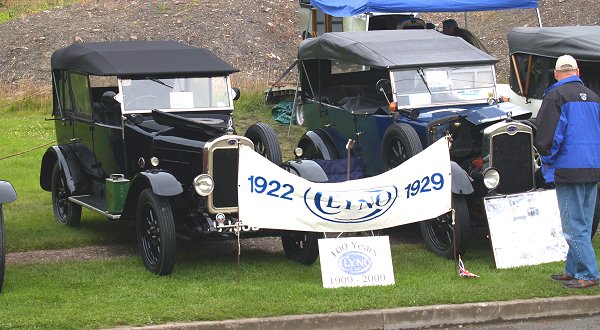
A close-up view of part of the Clyno display at
the 2009 Festival of Black Country Vehicles.
| I would like to thank Chris Smith, the grandson of Ailwyn, for his help, and the material that he has supplied
for this section. There is a Clyno
Owners Club and Register web site for owners and enthusiasts, at:
www.clyno.co.uk |

|
Return
to the List of Manufacturers |
|

